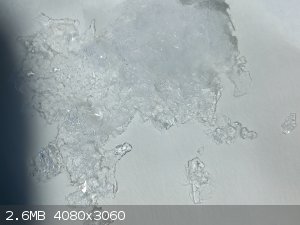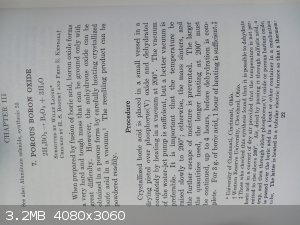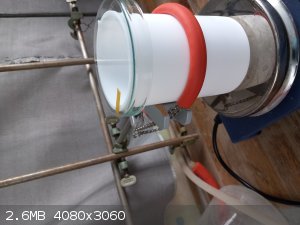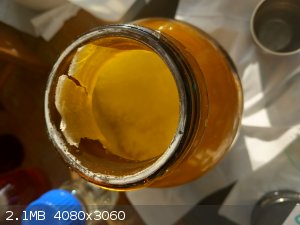Bedlasky
International Hazard
    
Posts: 1219
Registered: 15-4-2019
Location: Period 5, group 6
Member Is Offline
Mood: Volatile
|
|
NH4[BF4] synthesis question
Hi!
I want to try synthesis of NH4[BF4] (and maybe later some related salts like [SiF6]2-, [AlF6]3-, [TiF6]2-). Here is procedure from Prepchem:
https://prepchem.com/synthesis-of-ammonium-fluoroborate/
They say: No appreciable amounts of hydrogen fluoride should be lost through volatilization during the addition.
Later on it is mentioned heating on a steam bath for 0,5 hour. I am little bit concerned about this step, because fluoride + acid + heating --> HF.
Although in this stage all fluoride will be probably in the form of stable [BF4]-. I will do this in a fume hood, but are there any extra precautions
I should take? Is this dangerous like working with HF?
|
|
|
teodor
National Hazard
   
Posts: 872
Registered: 28-6-2019
Location: Heerenveen
Member Is Offline
|
|
Hi Bedlasky.
I also plan to make ammonium tetrafluoborate but by slightly different procedure:
2NH4HF2 + H3BO3 -> NH4BF4 + 3H2O + NH3
I was also tried to estimate HF fumes danger. So, I looked at IDLG/OSHA PEL table to estimate is my fume hood is adequate protection:
Formic acid 30/5
NO2 20/5
HF 30 ppm/3 ppm (IDLH / OSHA PEL)
HBr 25/3
HNO3 25/2
Chlorine 30/1
SOCl2 ?/1
So, it looks like it is in the range of compounds I was already working. The issue could be some residue in a hood itself. Probably it is a good idea
to use additional local suction or to do this outside.
I will share my experience if I will try this experiment.
[Edited on 4-6-2023 by teodor]
|
|
|
teodor
National Hazard
   
Posts: 872
Registered: 28-6-2019
Location: Heerenveen
Member Is Offline
|
|
Some update (I've started the planning).
I think in the reactions like this as well as HF + B2O3 it is hard to expect full consumption of the acid.
I am looking in the procedure from Inorganic Syntheses, V. II which I mentioned.
It says: 33g NH4HF2 + 13g H3BO3. It is far from perfect stoichiometry (17.885g H3BO3). Even under these conditions H3BO3 "slowly goes into solution
and turbidity disappeares on concentrating on a water bath".
So, to dissolve H3BO3 9g excess of NH4HF2 is used which can give max 3g / 0.16 mol ~ 3.6l HF on heating.
Roughly estimating ppm (by volume) to get 3 ppm it should be mixed with 1200000l of air or, taking in account the difference in the molar masses (20
vs 29) ~830 m3.
It is the amount of air containing in the semisphere of radius 15-16 meters.
What is incorrect in those calculation is the assumptions that the excess of NH4HF2 is totally decomposing, which is not the case (the temp. of
decomposition is 240C). So it estimates only the upper limit. Probably I would start with observations / detection are any fumes at all (wet indicator
paper / ?).
[Edited on 5-6-2023 by teodor]
|
|
|
Fery
National Hazard
   
Posts: 990
Registered: 27-8-2019
Location: Czechoslovakia
Member Is Offline
|
|
Is it necessary to consume almost all the H3BO3 to prevent your product contamination due to H3BO3 low solubility ???
Common HF2- salts are stable in water solution, they decompose at much higher temperatures than b.p. of water. They etch glass so commercial samples
are stored in plastic bottles.
|
|
|
teodor
National Hazard
   
Posts: 872
Registered: 28-6-2019
Location: Heerenveen
Member Is Offline
|
|
Thanks Fery.
So, I did the first part of the experiment - dissolving H3BO3 in NH4HF2 solution.
This is only a short resume. If somebody is interested in fotos/detailed description please let me know.
1. In 100 ml of water in PTFE beaker 33g NH4HF2 was dissolved. This part contains some danger because crystalls have tendency to stick to things and
be lost, so be careful.
The pH of the solution (by an universal indicator paper) is 3.
2. 13g H3BO3 was added and stirring on 150rpm was started. The beaker was covered by a petry dish with adhering indicator strip which was moistened
with water.
It looks like the water becomes cold, I am not sure on which step. But the process doesn't warm the solution. NH3 was not detected.
3. In 40 mins H3BO3 was completely dissolved. pH of the solution is 5.5 - 6. No NH3 smell detected on a test paper. No change on the paper adhering to
the petri dish was observed, at least in the part which was inside the beaker.
So, this reaction is quite unique because 2 acids reacts to make some almost neutral solution. I don't expect much HF fumes during the evaporation
step, because it looks like 0.29 mols of NH3 was consumed by the solution containing only 0.16 mols excess of NH4HF2
NH4HF2 + NH3 -> 2NH4F
As I know on heating:
NH4F -> NH3 + NH4HF2
|
|
|
teodor
National Hazard
   
Posts: 872
Registered: 28-6-2019
Location: Heerenveen
Member Is Offline
|
|
Yesterday I did evaporation of the solution on a water bath 95C.
From time to time I covered the beaker with a petri dish and checked pH of the condensate.
Mostly the reaction of the condensate was alkaline. But it doesn't smell ammonia or anything. Also, it looks there is irregularity in reaction -
between neutral and pH=~7. But the solution, unlike the condensate, always had neutral reaction. Also there are constantly bubbles of some gas on
walls. When the beaker was left few hours on sunlight, only this time it gave acidic condensate, but I am not sure about the reason - there are some
acid bottles staying in my fume hood, it could be sunlight can increase the evaporation.
So, periodically checking the pH of the condensat I managed to evaporate it until the crystalls of NH4BF4 had appeared. I did it just in a room
without any appriciable ventilation and today I feel good.
But taking in an account noticed irregularities in fume pH and the not investigated sunlight effect, I would recommend:
1. Make sure the pH of the solution is close to neutral before evaporation.
2. Periodically check the pH of the condensate.
3. Exclude direct sunlight.
[Edit]
I didn't notice mentioned turbidity, H3BO3 reacted completely before starting of the evaporation. I think could depend on its purity.
[Edited on 6-6-2023 by teodor]
|
|
|
woelen
Super Administrator
        
Posts: 7977
Registered: 20-8-2005
Location: Netherlands
Member Is Offline
Mood: interested
|
|
I'm not sure about purity of OTC H3BO3 (e.g. it is used for killing ants, it also is used for certain household cleaning purposes). For this reason I
purchased a little high-purity B2O3 from Onyxmet. This is more expensive than the H3BO3 you can buy at drogisterij.nl or similar companies, but I
trust this material more. B2O3 works as well as H3BO3, in many aqueous experiments you can exchange these chemicals.
I intend to use it for converting my HF to a solution of HBF4 in water. I want to get rid of the HF, but do not simply discard it. With HF, the
reaction of boric acid or boron oxide is said to be much more exothermic than with NH4HF2, so I'll be very careful with this.
|
|
|
teodor
National Hazard
   
Posts: 872
Registered: 28-6-2019
Location: Heerenveen
Member Is Offline
|
|
Is BF4- anion stable in acidic water solution?
Also, probably it was your H3BO3 which I used for the reaction. The resulting solution was one of the clearest water solution I ever have seen.
[Edited on 6-6-2023 by teodor]
The chemistry of B(OH)3 reaction with HF is 2 steps process:
1. B(OH)3 + 4HF -> HBF3OH + HF + H2O (fast)
2. HBF3OH + HF <-> HBF4 + H2O (slow, also equilibrium)
So, to keep HBF4 in the solution you still need some HF excess.
[Edited on 6-6-2023 by teodor]
|
|
|
woelen
Super Administrator
        
Posts: 7977
Registered: 20-8-2005
Location: Netherlands
Member Is Offline
Mood: interested
|
|
The ion BF4(-) is quite stable in water, but there is some hydrolysis.
The H3BO3 I have is quite pure, but it still is OTC stuff from an eBay seller (who sold it as ant killer). The B2O3 I ordered is from Onyxmet, and is
sold as chemical reagent. Probably better. For many experiments, the H3BO3 is fine, but I want my HF nopt to be contaminated with unknown (possibly
colorless and clear) impurities, hence the choice of using reagent grade B2O3 for that.
Making B2O3 yourself also can be done. You need to heat H3BO3 in order to drive off water. The first molecule of water is easily driven off, leading
to formation of HBO2. Driving off the last molecule of water requires much stronger heating and this is where problems occur. The stronger heating
requires the use of a metal container instead of glass and this easily leads to contamination of the product, due to oxidation of the metal by oxygen
from the air. In the past I tried making B2O3 in an iron container, but the resulting product always became brown.
|
|
|
teodor
National Hazard
   
Posts: 872
Registered: 28-6-2019
Location: Heerenveen
Member Is Offline
|
|
After evaporation to 60 ml and cooling I've got a lot of crystalls of NH4BF4. They are look very similar to ice which is formed in distilled water - a
very thin glass-like plates.

[Edited on 6-6-2023 by teodor]
And this is about B2O3 preparation:

Update
Now I am trying to prepare the compound using NH4F as a starting material.
[Edited on 6-6-2023 by teodor]
|
|
|
teodor
National Hazard
   
Posts: 872
Registered: 28-6-2019
Location: Heerenveen
Member Is Offline
|
|
There are some observations which I have time to post, also the site is not reachable sometimes, so I try to use its availability now.
NH4F looks like a very hygroscopic salt but it is not. I tried to dry it over H2SO4 and there is no appreciable weight loss. I think this phenomen is
related to low melting point - 100C. Also, taking in consideration the easyness of its termal decomposition I assume the "wet" substance which makes
crystalls stick to each other is NH3 in a liquid form which have relatively high boiling point because of saturation with NH4HF2 at the room
temperature decomposition attempt. NH4HF2 × NH3 loss ammonia somewhere between 100 and 230C.
Based on this I think addition of H2SO4 to a water solution having excess of NH4F will only bind the excess of ammonia, but striping-off ammonia in a
vacuum dessicator should akso be a way to check.
For now I selected 3rd route. So I'll make update.
[Update]
I was wrong in serveral points.
1. As little as 0.07% of water makes NH4F very sticky. Dried over H2SO4 loosing 0.07% of its mass the salt becomes crumbly.
2. 2 molecules from 6 NH3 in the hexagonal crystal pattern are really loosely connected and can leave the crystalls. But the problem is that NH4F is
not soluble in NH3, so it doesn't form anything like NH4F * nNH3. But it is highly soluble in HF and can form solid NH4F * nHF (n = 2..5).
3. The literature says that it lost ammonia only when wet, the water present in the melt or in water solution. Perfectly dry salts just sublimes.
4. I observed the sublimation heating the dry salt in a dessicator. The sublimation starts at ~50C / 44mmHg and covers walls with fog of crystalls.
[Edited on 7-6-2023 by teodor]
[Edited on 7-6-2023 by teodor]
|
|
|
teodor
National Hazard
   
Posts: 872
Registered: 28-6-2019
Location: Heerenveen
Member Is Offline
|
|
So, back to your original question.
I did this experiment.
In a dry glass test tube I put 0.466g of NH4F (max 0.5% wet, doesn't absorb more water) and 0.191g of H3BO3. Upon the contact NH4F began to melt and
the odour of ammonia became evident, the vapours had alkaline reaction.
4NH4F + H3BO3 = NH4BF4 + 3NH3 + 3H2O
Water which is generated catalizes decomposition of NH4F to NH4HF2 and NH3.
I took a heatgun and melt the mixture with air 120-130C. At this stage it was water-clear. There were lot of ammonia bubbles. The vapours are
stricktly alkaline.
I gradually increased the air temp up to 220C at which stage all liquid was evaporated and a white solid appeared. It was hard to make uniform mass
without stirring because it started to solidify on top and became just a some porous body due to evoporations from the bottom layer. I dryed the walls
of the test tube. After weighing I've got 0.346g of the context (I assume glass was not reacted, also I didn't noticed that but will check the weight
of the test tube change later).
And this is just almost a perfect stoichiometry:
4NH4F (0.466g) + H3BO3 (0.195g) = NH4BF4 (0.33g) + 3NH3 (0.16g) + 3H2O (0.17g)
So, don't need to add H2SO4.
[Correction]
I improperly calculated the water percentage in a "wet" salt, including the weight of a crucible in one of my previous posts. The correct sentence is:
" As little as 0.3% of water makes NH4F very sticky. Dried over H2SO4 loosing 0.3% of its mass the salt becomes crumbly"
[Update]
The residue in the test tube was dissolved in ~9 ml of water. The residue (H3BO3?) which won't to dissolved is less than ~1mg
[Edited on 8-6-2023 by teodor]
|
|
|
Bedlasky
International Hazard
    
Posts: 1219
Registered: 15-4-2019
Location: Period 5, group 6
Member Is Offline
Mood: Volatile
|
|
Teodor: Thanks for such detailed report! This is truly awesome work!
|
|
|
teodor
National Hazard
   
Posts: 872
Registered: 28-6-2019
Location: Heerenveen
Member Is Offline
|
|
Thank you!
I was already long time planning the experiment of making NH4BF4 and the last piece I have bought for that was this nice PTFE beaker.

Also I enjoy a special beaker holder which I've bought in laboratoriumdiscounter.nl and it proved itself as a really nice thing.
Fery presented me 2 bottles of NH4F (thanks Fery!) which he thought was melted and reacted with glass but it wasn't. Just the bottle has a parafine
coat inside which was looking as a melted salt from outside.

I have cleaned and dried the test tube (duran glass) where I did the melting. So, now I can report the weight change:
The weight before the experiment: 17.596g
The weight after the experiment: 17.593g
So, it looks like H3BO3 is much more reactive for F- than SiO2 and having it in the mix adequately protect glassware.
It could be still a very tiny sublimation of NH4F / NH4HF2. I observed something like 2-3 microcrystalls on the tube walls but I didn't check is it
really crystalls or drops of water. But not more than that - the test tube is a very convenient device for studing vapours structure. For big scale
you can try to use a distillation setup.
[Edited on 9-6-2023 by teodor]
|
|
|
Admagistr
Hazard to Others
  
Posts: 350
Registered: 4-11-2021
Location: Central Europe
Member Is Offline
Mood: The dreaming alchemist
|
|
What can NH4BF4 be used for?Here is a link to an interesting article that it has been discovered in nature as a new volcanic mineral:
http://www.minsocam.org/ammin/am79/am79_381.pdf
|
|
|
Bedlasky
International Hazard
    
Posts: 1219
Registered: 15-4-2019
Location: Period 5, group 6
Member Is Offline
Mood: Volatile
|
|
That's interesting! [BF4]- anion is often used as non-coordinating anion. It can also be used for synthesis of fluoroarenes via diazonium
intermediate.
|
|
|
teodor
National Hazard
   
Posts: 872
Registered: 28-6-2019
Location: Heerenveen
Member Is Offline
|
|
For me NH4BF4 is a precursor to BF3 and its reach chemistry.
|
|
|
Admagistr
Hazard to Others
  
Posts: 350
Registered: 4-11-2021
Location: Central Europe
Member Is Offline
Mood: The dreaming alchemist
|
|
Thank you Bedlasky and Teodor for examples of the use of this compound.
[Edited on 13-6-2023 by Admagistr]
|
|
|